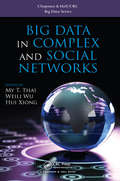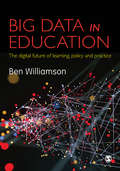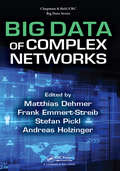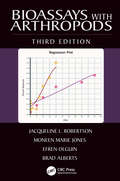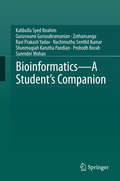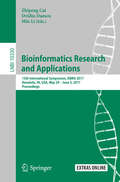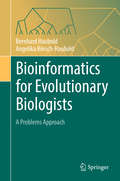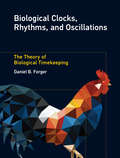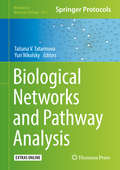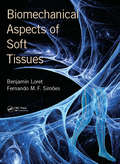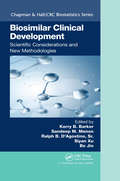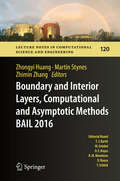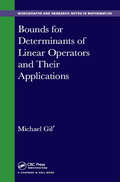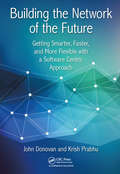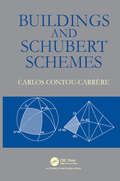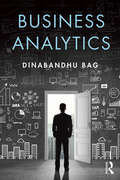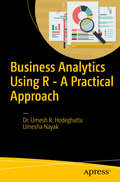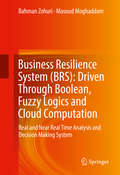- Table View
- List View
Big Data in Complex and Social Networks (Chapman & Hall/CRC Big Data Series)
by My T. Thai, Weili Wu, Hui XiongThis book presents recent developments on the theoretical, algorithmic, and application aspects of Big Data in Complex and Social Networks. The book consists of four parts, covering a wide range of topics. The first part of the book focuses on data storage and data processing. It explores how the efficient storage of data can fundamentally support intensive data access and queries, which enables sophisticated analysis. It also looks at how data processing and visualization help to communicate information clearly and efficiently. The second part of the book is devoted to the extraction of essential information and the prediction of web content. The book shows how Big Data analysis can be used to understand the interests, location, and search history of users and provide more accurate predictions of User Behavior. The latter two parts of the book cover the protection of privacy and security, and emergent applications of big data and social networks. It analyzes how to model rumor diffusion, identify misinformation from massive data, and design intervention strategies. Applications of big data and social networks in multilayer networks and multiparty systems are also covered in-depth.
Big Data in Education: The digital future of learning, policy and practice
by Ben WilliamsonBig data has the power to transform education and educational research. Governments, researchers and commercial companies are only beginning to understand the potential that big data offers in informing policy ideas, contributing to the development of new educational tools and innovative ways of conducting research. This cutting-edge overview explores the current state-of-play, looking at big data and the related topic of computer code to examine the implications for education and schooling for today and the near future. Key topics include: · The role of learning analytics and educational data science in schools · A critical appreciation of code, algorithms and infrastructures · The rise of ‘cognitive classrooms’, and the practical application of computational algorithms to learning environments · Important digital research methods issues for researchers This is essential reading for anyone studying or working in today's education environment!
Big Data in Education: The digital future of learning, policy and practice
by Ben WilliamsonBig data has the power to transform education and educational research. Governments, researchers and commercial companies are only beginning to understand the potential that big data offers in informing policy ideas, contributing to the development of new educational tools and innovative ways of conducting research. This cutting-edge overview explores the current state-of-play, looking at big data and the related topic of computer code to examine the implications for education and schooling for today and the near future. Key topics include: · The role of learning analytics and educational data science in schools · A critical appreciation of code, algorithms and infrastructures · The rise of ‘cognitive classrooms’, and the practical application of computational algorithms to learning environments · Important digital research methods issues for researchers This is essential reading for anyone studying or working in today's education environment!
Big Data of Complex Networks (Chapman & Hall/CRC Big Data Series)
by Matthias Dehmer, Frank Emmert-Streib, Stefan Pickl and Andreas HolzingerBig Data of Complex Networks presents and explains the methods from the study of big data that can be used in analysing massive structural data sets, including both very large networks and sets of graphs. As well as applying statistical analysis techniques like sampling and bootstrapping in an interdisciplinary manner to produce novel techniques for analyzing massive amounts of data, this book also explores the possibilities offered by the special aspects such as computer memory in investigating large sets of complex networks. Intended for computer scientists, statisticians and mathematicians interested in the big data and networks, Big Data of Complex Networks is also a valuable tool for researchers in the fields of visualization, data analysis, computer vision and bioinformatics. Key features: Provides a complete discussion of both the hardware and software used to organize big data Describes a wide range of useful applications for managing big data and resultant data sets Maintains a firm focus on massive data and large networks Unveils innovative techniques to help readers handle big data Matthias Dehmer received his PhD in computer science from the Darmstadt University of Technology, Germany. Currently, he is Professor at UMIT – The Health and Life Sciences University, Austria, and the Universität der Bundeswehr München. His research interests are in graph theory, data science, complex networks, complexity, statistics and information theory. Frank Emmert-Streib received his PhD in theoretical physics from the University of Bremen, and is currently Associate professor at Tampere University of Technology, Finland. His research interests are in the field of computational biology, machine learning and network medicine. Stefan Pickl holds a PhD in mathematics from the Darmstadt University of Technology, and is currently a Professor at Bundeswehr Universität München. His research interests are in operations research, systems biology, graph theory and discrete optimization. Andreas Holzinger received his PhD in cognitive science from Graz University and his habilitation (second PhD) in computer science from Graz University of Technology. He is head of the Holzinger Group HCI-KDD at the Medical University Graz and Visiting Professor for Machine Learning in Health Informatics Vienna University of Technology.
Big Ideas Math Advanced 2: A Bridge to Success, Student Edition
by Ron Larson Laurie BoswellBig Ideas Math Ms Advanced 2: A Bridge To Success, Student Edition
Big Ideas Math Green: A Common Core Curriculum
by Ron LarsonBIG IDEAS MATH® Green Common Core Curriculum Ron Larson Laurie Boswell
Big Ideas Math MS Blue: A Common Core Curriculum, Student Edition
by Ron LarsonThe revised Big Ideas Math series uses the same research-based strategy of a balanced approach to instruction that made the first Big Ideas Math series so successful. This approach opens doors to abstract thought, reasoning, and inquiry as students persevere to answer the Essential Questions that introduce each section. The foundation of the program is the Common Core Standards for Mathematical Content and Standards for Mathematical Practice. Students are subtly introduced to "Habits of Mind" that help them internalize concepts for a greater depth of understanding. These habits serve students well not only in mathematics, but across all curricula throughout their academic careers. The Big Ideas Math series exposes students to highly motivating and relevant problems. Woven throughout the series are the depth and rigor students need to prepare for career-readiness and other college-level courses. In addition, the Big Ideas Math series prepares students to meet the challenge of PARCC and Smarter Balanced testing.
Bioassays with Arthropods
by Efren Olguin Brad Alberts Jacqueline Robertson Moneen JonesImagine a statistics book for bioassays written by a statistician. Next, imagine a statistics book for bioassays written for a layman. Bioassays with Arthropods, Third Edition offers the best of both worlds by translating the terse, precise language of the statistician into language used by the laboratory scientist. The book explains the statistical basis and analysis for each kind of quantal response bioassay in just the right amount of detail. The first two editions were a great reference for designing, conducting, and interpreting bioassays: this completely revised and updated third edition will also train the laboratory scientist to be an expert in estimation of dose response curves. New in the Third Edition: Introduces four new Windows and Apple-based computer programs (PoloJR, OptiDose, PoloMixture and PoloMulti) for the analyses of binary and multiple response analyses, respectively Replaces out-of-date GLIM examples with R program samples Includes a new chapter, Population Toxicology, and takes a systems approach to bioassays Expands the coverage of invasive species and quarantine statistics Building on the foundation set by the much-cited first two editions, the authors clearly delineate applications and ideas that are exceptionally challenging for those not already familiar with their use. They lead you through the methods with such ease and organization, that you suddenly find yourself readily able to apply concepts that you never thought you would understand. To order the PoloSuite computer software described in Bioassays with Arthropods, Third Edition, use the order form found at www.leora-software.com or contact the LeOra Software Company at leorasoftware@gmail.com.
Bioinformatics - A Student's Companion
by Kalibulla Syed Ibrahim Guruswami Gurusubramanian Zothansanga Ravi Prakash Yadav Nachimuthu Senthil Kumar Shunmugiah Karutha Pandian Probodh Borah Surender MohanThis manual offers a stand-alone reading companion, unique in simplifying the practical components of Bioinformatics in a unique and user-friendly manner. It covers the practical component of syllabi used at most leading universities and discusses the most extensively used tools and methodologies in Bioinformatics. Research in the biological sciences has made tremendous strides in recent years due in part to the increased automation in data generation. At the same time, storing, managing and interpreting huge volumes of data has become one of the most challenging tasks for scientists. These two aspects have ultimately necessitated the application of computers, giving rise to a highly interdisciplinary discipline-Bioinformatics. Despite the richness of bioinformatics resources and methods, the exposure of life sciences undergraduates and postgraduates to bioinformatics is extremely limited. Though the internet offers various tools for free, and provides guides for using them, it fails to help users interpret the processed data. Moreover, most sites fail to update their help pages to accommodate software upgrades. Though the market is flooded with books discussing the theoretical concepts in Bioinformatics, a manual of this kind is rarely found. The content developed to meet the needs of readers from diverse background and to incorporate the syllabi of undergraduate and postgraduate courses at various universities.
Bioinformatics Research and Applications: 13th International Symposium, ISBRA 2017, Honolulu, HI, USA, May 29 – June 2, 2017, Proceedings (Lecture Notes in Computer Science #10330)
by Zhipeng Cai, Ovidiu Daescu and Min LiThis book constitutes the proceedings of the 13th International Symposium on Bioinformatics Research and Applications, ISBRA 2017, held in Honolulu, HI, USA, in May/June 2017. The 27 full papers presented together with 18 short papers and 24 invited abstracts were carefully reviewed and selected from 131 submissions. They cover topics such as: biomarker discovery; biomedical databases and data integration; biomedical text mining and ortologies; biomolecular imaging; comparative genomics; computational genetic epidemiology; computational proteomics; data mining and visualization; gene expression analysis; genome analysis; high-performance bio-computing; metagenomics; molecular evolution; molecular modelling and simulation; next-generation sequencing data analysis; pattern discovery and classification; population genetics; software tools and applications; structural biology; and systems biology.
Bioinformatics for Evolutionary Biologists: A Problems Approach
by Bernhard Haubold Angelika Börsch-HauboldThis self-contained textbook covers fundamental aspects of sequence analysis in evolutionary biology, including sequence alignment, phylogeny reconstruction, and coalescent simulation. It addresses these aspects through a series of over 400 computer problems, ranging from elementary to research level to enable learning by doing. Students solve the problems in the same computational environment used for decades in science - the UNIX command line. This is available on all three major operating systems for PCs: Microsoft Windows, Mac-OSX, and Linux. To learn using this powerful system, students analyze sample sequence data by applying generic tools, bioinformatics software, and over 40 programs specifically written for this course. The solutions for all problems are included, making the book ideal for self-study. Problems are grouped into sections headed by an introduction and a list of new concepts and programs. By using practical computing to explore evolutionary concepts and sequence data, the book enables readers to tackle their own computational problems.
Biological Clocks, Rhythms, and Oscillations: The Theory of Biological Timekeeping (The\mit Press Ser.)
by Daniel B. ForgerAn introduction to the mathematical, computational, and analytical techniques used for modeling biological rhythms, presenting tools from many disciplines and example applications.All areas of biology and medicine contain rhythms, and these behaviors are best understood through mathematical tools and techniques. This book offers a survey of mathematical, computational, and analytical techniques used for modeling biological rhythms, gathering these methods for the first time in one volume. Drawing on material from such disciplines as mathematical biology, nonlinear dynamics, physics, statistics, and engineering, it presents practical advice and techniques for studying biological rhythms, with a common language. The chapters proceed with increasing mathematical abstraction. Part I, on models, highlights the implicit assumptions and common pitfalls of modeling, and is accessible to readers with basic knowledge of differential equations and linear algebra. Part II, on behaviors, focuses on simpler models, describing common properties of biological rhythms that range from the firing properties of squid giant axon to human circadian rhythms. Part III, on mathematical techniques, guides readers who have specific models or goals in mind. Sections on “frontiers” present the latest research; “theory” sections present interesting mathematical results using more accessible approaches than can be found elsewhere. Each chapter offers exercises. Commented MATLAB code is provided to help readers get practical experience. The book, by an expert in the field, can be used as a textbook for undergraduate courses in mathematical biology or graduate courses in modeling biological rhythms and as a reference for researchers.
Biological Networks and Pathway Analysis (Methods in Molecular Biology #1613)
by Yuri Nikolsky Tatiana V. TatarinovaIn this volume, expert practitioners present a compilation of methods of functional data analysis (often referred to as "systems biology") and its applications in drug discovery, medicine, and basic disease research. It covers such important issues as the elucidation of protein, compound and gene interactions, as well as analytical tools, including networks, interactome and ontologies, and clinical applications of functional analysis. As a volume in the highly successful Methods in Molecular Biology series, this work provides detailed description and hands-on implementation advice. Reputable, comprehensive, and cutting-edge, Biological Networks and Pathway Analysis presents both "wet lab" experimental methods and computational tools in order to cover a broad spectrum of issues in this fascinating new field.
Biomechanical Aspects of Soft Tissues
by Benjamin Loret Fernando Manuel SimoesBiomechanics applies the laws and techniques of mechanics in the study of biological systems and related phenomena. Biomechanics uses mathematical and computational tools such as model construction of musclo-skeletal system, body fluid circulation, to aid medical diagnosis, therapeutics and surgery planning, designing of prostheses and implants or in tissue engineering. Present book targets specific topics pertaining to the biomechanics of soft tissues. Subjects addressed includes solids and multi-species mixtures as open systems: a continuum mechanics perspective; electro-chemo-mechanical couplings: tissues with a fixed electric charge and growth of biological tissues.
Biosimilar Clinical Development: Scientific Considerations and New Methodologies (Chapman & Hall/CRC Biostatistics Series)
by Kerry B. Barker Sandeep M. Menon Siyan Xu Bo Jin Ralph B. D’Agostino Sr.Biosimilars have the potential to change the way we think about, identify, and manage health problems. They are already impacting both clinical research and patient care, and this impact will only grow as our understanding and technologies improve. Written by a team of experienced specialists in clinical development, this book discusses various potential drug development strategies, the design and analysis of pharmacokinetics (PK) studies, and the design and analysis of efficacy studies.
Boundary and Interior Layers, Computational and Asymptotic Methods BAIL 2016 (Lecture Notes in Computational Science and Engineering #120)
by Zhongyi Huang Martin Stynes Zhimin ZhangThis volume collects papers associated with lectures that were presented at the BAIL 2016 conference, which was held from 14 to 19 August 2016 at Beijing Computational Science Research Center and Tsinghua University in Beijing, China. It showcases the variety and quality of current research into numerical and asymptotic methods for theoretical and practical problems whose solutions involve layer phenomena. The BAIL (Boundary And Interior Layers) conferences, held usually in even-numbered years, bring together mathematicians and engineers/physicists whose research involves layer phenomena, with the aim of promoting interaction between these often-separate disciplines. These layers appear as solutions of singularly perturbed differential equations of various types, and are common in physical problems, most notably in fluid dynamics. This book is of interest for current researchers from mathematics, engineering and physics whose work involves the accurate app roximation of solutions of singularly perturbed differential equations; that is, problems whose solutions exhibit boundary and/or interior layers.
Bounds for Determinants of Linear Operators and their Applications (Chapman & Hall/CRC Monographs and Research Notes in Mathematics)
by Michael Gil'This book deals with the determinants of linear operators in Euclidean, Hilbert and Banach spaces. Determinants of operators give us an important tool for solving linear equations and invertibility conditions for linear operators, enable us to describe the spectra, to evaluate the multiplicities of eigenvalues, etc. We derive upper and lower bounds, and perturbation results for determinants, and discuss applications of our theoretical results to spectrum perturbations, matrix equations, two parameter eigenvalue problems, as well as to differential, difference and functional-differential equations.
Bridges in Mathematics, Home Connections, Grade 2, Volume 1, Spanish Edition
by The Math Learning CenterNIMAC-sourced textbook
Bridges in Mathematics: Student Book, Volume 1
by The Math Learning CenterBridges to Mathematics, Student Book, Grade 4, Volume 1, Second Edition
Bubbles and Contagion in Financial Markets, Volume 2: Models and Mathematics
by Eva R. PorrasThis book focuses on extending the models and theories (from a mathematical/statistical point of view) which were introduced in the first volume to a more technical level. Where volume I provided an introduction to the mathematics of bubbles and contagion, volume II digs far more deeply and widely into the modeling aspects.
Building the Network of the Future: Getting Smarter, Faster, and More Flexible with a Software Centric Approach
by Greg Stiegler and John DeCastraFrom the Foreword: "This book lays out much of what we’ve learned at AT&T about SDN and NFV. Some of the smartest network experts in the industry have drawn a map to help you navigate this journey. Their goal isn’t to predict the future but to help you design and build a network that will be ready for whatever that future holds. Because if there’s one thing the last decade has taught us, it’s that network demand will always exceed expectations. This book will help you get ready."—Randall Stephenson, Chairman, CEO, and President of AT&T "Software is changing the world, and networks too. In this in-depth book, AT&T's top networking experts discuss how they're moving software-defined networking from concept to practice, and why it's a business imperative to do this rapidly."—Urs Hölzle, SVP Cloud Infrastructure, Google "Telecom operators face a continuous challenge for more agility to serve their customers with a better customer experience and a lower cost. This book is a very inspiring and vivid testimony of the huge transformation this means, not only for the networks but for the entire companies, and how AT&T is leading it. It provides a lot of very deep insights about the technical challenges telecom engineers are facing today. Beyond AT&T, I’m sure this book will be extremely helpful to the whole industry."—Alain Maloberti, Group Chief Network Officer, Orange Labs Networks "This new book should be read by any organization faced with a future driven by a "shift to software." It is a holistic view of how AT&T has transformed its core infrastructure from hardware based to largely software based to lower costs and speed innovation. To do so, AT&T had to redefine their technology supply chain, retrain their workforce, and move toward open source user-driven innovation; all while managing one of the biggest networks in the world. It is an amazing feat that will put AT&T in a leading position for years to come."—Jim Zemlin, Executive Director, The Linux Foundation This book is based on the lessons learned from AT&T’s software transformation journey starting in 2012 when rampant traffic growth necessitated a change in network architecture and design. Using new technologies such as NFV, SDN, Cloud, and Big Data, AT&T’s engineers outlined and implemented a radical network transformation program that dramatically reduced capital and operating expenditures. This book describes the transformation in substantial detail. The subject matter is of great interest to telecom professionals worldwide, as well as academic researchers looking to apply the latest techniques in computer science to solving telecom’s big problems around scalability, resilience, and survivability.
Buildings and Schubert Schemes
by Carlos Contou-CarrereThe first part of this book introduces the Schubert Cells and varieties of the general linear group Gl (k^(r+1)) over a field k according to Ehresmann geometric way. Smooth resolutions for these varieties are constructed in terms of Flag Configurations in k^(r+1) given by linear graphs called Minimal Galleries. In the second part, Schubert Schemes, the Universal Schubert Scheme and their Canonical Smooth Resolution, in terms of the incidence relation in a Tits relative building are constructed for a Reductive Group Scheme as in Grothendieck's SGAIII. This is a topic where algebra and algebraic geometry, combinatorics, and group theory interact in unusual and deep ways.
Business Analytics
by Dinabandhu BagThis book provides a first-hand account of business analytics and its implementation, and an account of the brief theoretical framework underpinning each component of business analytics. The themes of the book include (1) learning the contours and boundaries of business analytics which are in scope; (2) understanding the organization design aspects of an analytical organization; (3) providing knowledge on the domain focus of developing business activities for financial impact in functional analysis; and (4) deriving a whole gamut of business use cases in a variety of situations to apply the techniques. The book gives a complete, insightful understanding of developing and implementing analytical solution.
Business Analytics Using R - A Practical Approach: A Practical Approach
by Umesh R. Hodeghatta Umesh NayakLearn the fundamental aspects of the business statistics, data mining, and machine learning techniques required to understand the huge amount of data generated by your organization. This book explains practical business analytics through examples, covers the steps involved in using it correctly, and shows you the context in which a particular technique does not make sense. Further, Practical Business Analytics using R helps you understand specific issues faced by organizations and how the solutions to these issues can be facilitated by business analytics. This book will discuss and explore the following through examples and case studies: An introduction to R: data management and R functions The architecture, framework, and life cycle of a business analytics project Descriptive analytics using R: descriptive statistics and data cleaning Data mining: classification, association rules, and clustering Predictive analytics: simple regression, multiple regression, and logistic regression This book includes case studies on important business analytic techniques, such as classification, association, clustering, and regression. The R language is the statistical tool used to demonstrate the concepts throughout the book. What You Will Learn * Write R programs to handle data * Build analytical models and draw useful inferences from them * Discover the basic concepts of data mining and machine learning * Carry out predictive modeling * Define a business issue as an analytical problem Who This Book Is For Beginners who want to understand and learn the fundamentals of analytics using R. Students, managers, executives, strategy and planning professionals, software professionals, and BI/DW professionals.
Business Resilience System (BRS) (BRS): Real and Near Real Time Analysis and Decision Making System
by Bahman Zohuri Masoud MoghaddamThis book provides a technical approach to a Business Resilience System with its Risk Atom and Processing Data Point based on fuzzy logic and cloud computation in real time. Its purpose and objectives define a clear set of expectations for Organizations and Enterprises so their network system and supply chain are totally resilient and protected against cyber-attacks, manmade threats, and natural disasters. These enterprises include financial, organizational, homeland security, and supply chain operations with multi-point manufacturing across the world. Market shares and marketing advantages are expected to result from the implementation of the system. The collected information and defined objectives form the basis to monitor and analyze the data through cloud computation, and will guarantee the success of their survivability's against any unexpected threats. This book will be useful for advanced undergraduate and graduate students in the field of computer engineering, engineers that work for manufacturing companies, business analysts in retail and e-Commerce, and those working in the defense industry, Information Security, and Information Technology.
